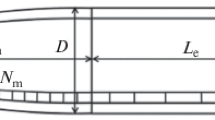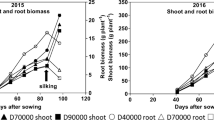Abstract
The timing of root production is one of the parameters required for modelling the root system architecture. The objectives of this study are (1) to describe the rate of appearance of adventitious root primordia of maize and their rate of emergence out of the stem; (2) to test equations for the prediction of the rank of the phytomer on which root emergence occurs, in a wide range of field situations.
Maize, cultivar Dea, was grown in controlled conditions and in the field in 1987, 1988, 1989 and 1991. Plants were regularly sampled and the following data were recorded: foliar stage, number of root primordia and number of emerged roots per phytomer. Root primordia were counted in transverse thin sections in the stem.
At a single plant level, root primordia differentiation occurred sequentially on the successive phytomers, with no overlapping between two phytomers. The same was true for root emergence. Roots belonging to the same phytomer emerged at approximately the same time.
At a plant population level, there was a linear relationship between the rank of the phytomer on which root primordia were differentiated and cumulated degree-days after sowing. A linear relationship was also observed between the rank of the phytomer on which roots were emerging and cumulated degree-days or foliar stage. In the range of field situations tested (several years, sowing dates and planting densities), both equations gave an accurate prediction of the timing of root emergence during the plant cycle.
Similar content being viewed by others
References
DiggleA J 1988 ROOTMAP, a model in three dimensional coordinates of the growth and structure of fibrous root systems. Plant and Soil 105, 169–178.
DutandR, BonhommeR and DerieuxM 1982 Seuil optimal des sommes de températures: Application au maïs (Zea mays L.). Agronomie 2, 589–597.
GirardinP, JordanM O, PicardD and TrendelR 1986 Harmonisation des notations concernant la description morphologique d'un pied de maïs (Zea mays L.). Agronomie 6, 873–875.
GirardinP, Morel-FourrierB, JordanM O and MilletB 1987 Développement des racines adventives chez le maïs. Agronomie 7, 353–360.
HoppeD C, MacCullyM E and WenzelC L 1986 The nodal roots of Zea: Their development in relation to structural features of the stem. Can. J. Bot. 64, 2524–2537.
JordanM O, GirardinP, Varlet-GrancherC, PicardD and TrendelR 1988 Rythme d'apparition des racines primaires du maïs (Zea mays L.). III. Variations observées au champ. Agronomie 8, 37–46.
PagesL and JordanM O 1991 Root structure of corn (Zea mays L.). 2. A three-dimensional simulation model. In Plant Roots and Their Environment. Eds. B LMcMichael and HPersson. pp 608–619. Elsevier Science Publishers, Amsterdam, The Netherlands.
PicardD, JordanM O and TrendelR 1985. Rythme d'apparition des racines primaires du maïs (Zea mays L.). I. Etude detaillée pour une variété en un lieu donné. Agronomie 5, 667–676.
SAS Institute, Inc. 1988 SAS User's Guide. SAS Inst., Inc., Cary, NC.
WallachD and GoffinetB 1989 Mean squared error of prediction as a criterion for evaluating and comparing system models Ecol. Modelling 44, 299–306.
Author information
Authors and Affiliations
Rights and permissions
About this article
Cite this article
Sylvain, P. Rate of differentiation and emergence of nodal maize roots. Plant Soil 148, 155–161 (1993). https://doi.org/10.1007/BF00012853
Received:
Accepted:
Issue Date:
DOI: https://doi.org/10.1007/BF00012853




